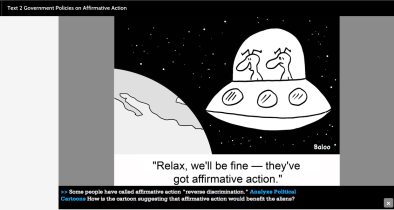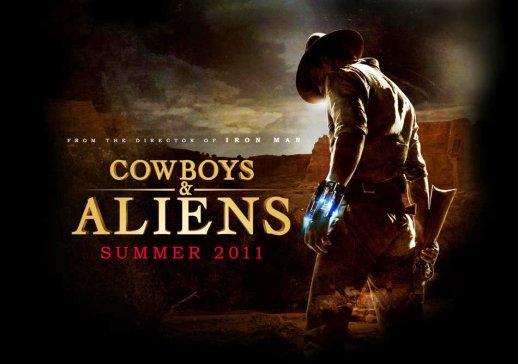Cloaking Inequity: Aliens Laud Affirmative Action In Texas Social Studies Curriculum (Really)

I am not lying to you. Yes, Texas textbook designers have found a new way to deride social progress by using aliens as their muse. But first, the peer reviewed academic material. In 2012, the post “Illusion of Inclusion,” Article about Race and Standards in Harvard Educational Review introduced a peer reviewed textual analysis of the Texas Social Studies Standards.
In this article, Julian Vasquez Heilig, Keffrelyn Brown, and Anthony Brown offer findings from a close textual analysis of how the Texas social studies standards address race, racism, and communities of color. Using the lens of Critical Race Theory, the authors uncover the sometimes subtle ways that the standards can appear to adequately address race while at the same time marginalizing it—the “illusion of inclusion.” Their study offers insight into the mechanisms of marginalization in standards and a model of how to closely analyze such standards, which, the authors argue, is increasingly important as the standards and accountability movements continue to grow in influence.
Citation: Vasquez Heilig, J., Brown, K. & Brown, A. (2012). The illusion of inclusion: Race and standards. Harvard Educational Review, 83(3), 403-424.*
Well, the textbooks based on the Texas State Board of Education’s revision to the Texas social studies standards are likely headed to a classroom in Texas and perhaps near you (if your state adopts this nonsense). Today MSNBC wrote
A [Texas] textbook based on the same controversial standards suggests Jim Crow sometimes wasn’t that big of a deal. “Under segregation, all-white and all-African American schools sometimes had similar buildings, buses, and teachers,” it says. “Sometimes, however, the buildings, buses, and teachers for the all-black schools were lower in quality.”
And a U.S. history textbook mentions segregation only in a passing reference to the 1948 integration of the armed forces.
The Republican Party doesn’t appear to like history that includes critical and diverse perspectives. MSNBC also wrote
Even the national Republican Party is focused on the issue. Last month, when the College Board released a new “curriculum framework” for the U.S. history test that involves a greater focus on women and minorities, the Republican National Committee called it a “radically revisionist view of American history that emphasizes negative aspects of our nation’s history while omitting or minimizing positive aspects.”
So about those aliens and their social studies ideas. Maybe you had thought you had heard it all from Texas educational policy cowboys. But alas, no. Texas is using aliens in cartoon to push a “conservative” (hostile) perspective on Affirmative Action in the social studies curriculum.
The Texas Freedom Network wrote this about the cartoons in the proposed Texas social studies curriculum:
The text also makes the ideological, unwarranted, and unsubstantiated prediction that “[i]t seems clear that the days of affirmative action programs are drawing to a close.” The evidence the text provides to support this claim is inadequate and lopsided. The text rests its claim in part on a Supreme Court case striking down an affirmative action policy (Ricci v. DeStefano) that was decided by a 5-4 margin. This means, of course, that the replacement of just a single Supreme Court justice could lead to very different outcomes in future cases regarding affirmative action. In addition, the federal government and state governments continue to maintain and even expand various types of affirmative action programs. To use just one recent example, in July 2014 Virginia Governor Terry McAuliffe signed an executive order designed to expand contracting opportunities to small, women-owned and minority-owned businesses. It is also at least plausible to predict that the increasing proportion of minorities in the nation at large and in individual states could lead to greater public pressure for the adoption or maintenance of affirmative action policies. On a related note, defenders of affirmative action would argue that recent bans on affirmative action provide reason for voters to affirm the continued relevance of these programs. The University of Michigan claims, for instance, that minority enrollment dropped 33 percent from 2006 to 2012 after Michigan voters adopted the Michigan Civil Rights Initiative (also known as Proposal 2) in 2006. In light of the text’s neglect to mention any evidence possibly contradicting its prediction, it is difficult not to suspect that this prediction, which has little pedagogical or descriptive value for students, is intended to persuade students about the illegitimacy of affirmative action.
This suspicion receives further confirmation from the inclusion of a clickable box that identifies states that have banned affirmative action. The caption accompanying this chart reads: “Affirmative action has been attacked most often in education…Why might states believe that banning affirmative action is beneficial to them from an economic standpoint?” The text does not include a similar chart identifying the states that have maintained affirmative action policies or one encouraging students to consider the possible economic and non-economic benefits of maintaining or expanding affirmative action. In addition, the sole textbook review question on affirmative action in this section further encourages students to question or oppose affirmative action. The multiple-choice question asks: “The Supreme Court applies strict scrutiny to affirmative action quotas because . . .” The correct answer is that “quotas make it impossible to choose individuals on a case-by-case basis.” The text provides no question suggesting why affirmative action programs might be consistent with the Constitution.
So besides the potential Texas social studies curriculum being biased, it is also deceptive and inaccurate. So will the Texas State Board of Education approve this nonsense so that more than 4.5 million students can encounter aliens instructive opinions about Affirmative Action in their high-stakes exams? MSNBC writes,
Before the board decides on whether to approve the books for teaching to Texas’s 5.1 million, majority-Hispanic public-school students, a 140-member review panel, appointed by the board, will submit reports on whether the books are accurate and conform to the standards. But it may not be a panel that inspires much trust.
In July, TFN noted that just three of the panel’s members are faculty of Texas colleges and universities. It said several well-qualified academics applied to serve but were rejected. Instead, the review panel includes a pastor and tea party-aligned Republican candidate for the Texas legislature, who pledges on his campaign website to “do everything within my power to protect the lives of the unborn and protect our families by being a gatekeeper of our right to bear arms.”
The board will hold public hearings before deciding whether to approve the books.
Beer, bait, guns and inaccurate/deceptive social studies curriculum. Texas. :) From fiction to reality in the Texas social studies standards…
This blog post has been shared by permission from the author.
Readers wishing to comment on the content are encouraged to do so via the link to the original post.
Find the original post here:
The views expressed by the blogger are not necessarily those of NEPC.



